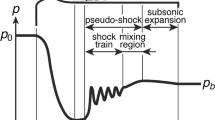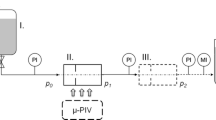Abstract
In the present study, the characteristics of supersonic flows in micronozzles are experimentally and computationally investigated for Reynolds numbers ranging from 618 to 5560. In the experiments, the flows are created in a rectangular contoured nozzle whose heights at its throat and exit are 286 and 500 μm, respectively. The number-density distribution along the nozzle centerline is measured using the laser-induced fluorescence technique under an underexpanded condition for each Reynolds number. The experimental results reveal that the underexpanded flow expands along the streamwise direction in a range where the cross-sectional area of the nozzle is constant although the flow in such a range has been believed to be compressed owing to friction. The results also reveal that the unexpected range where the flow expands extends with a decrease in Reynolds number. In the computations, the Navier–Stokes equations are solved numerically. The computational results agree very well with the experimental results; i.e., the computational code used in the present study is validated by the experiments. By using the computational results, the reason for the appearance of the phenomena peculiar to supersonic micronozzle flows is discussed. As a result, it is found that information about the back pressure under which the flow is underexpanded can reach into the inside of a micronozzle. Such a property induces the unexpected phenomena observed in the experiments.














Similar content being viewed by others
References
Anderson JD (1995) Computational fluid dynamics. McGraw-Hill, New York
Aniskin V, Mironov S, Maslov A (2013) Investigation of the structure of supersonic nitrogen microjets. Microfluid Nanofluid 14:605–614
Bruccoleri AR, Leiter R, Drela M, Lozano P (2012) Experimental effects of nozzle geometry on flow efficiency at low Reynolds numbers. J Propuls Power 28:96–105
Bryant RA, Donbar JM, Driscoll JF (2000) Acetone laser induced fluorescence for low pressure/low temperature flow visualization. Exp Fluids 28:471–476
Chong X (2006) Subsonic choked flow in the microchannel. Phys Fluids 18:127104
Fan Y, Suzuki Y, Kasagi N (2006) Development of a large-entrainment-ratio axisymmetric supersonic ejector for micro butane combustor. J Micromech Microeng 16:S211–S219
Handa T, Masuda M, Kashitani M, Yamaguchi Y (2011) Measurement of number densities in supersonic flows using a method based on laser-induced acetone fluorescence. Exp Fluids 50:1685–1694
Handa T, Mii K, Sakurai T, Imamura K, Mizuta S, Ando Y (2014) Study on supersonic rectangular microjets using molecular tagging velocimetry. Exp Fluids 55:1725
Kolhe PS, Agrawal K (2009) Density measurement in a supersonic microjet using miniature rainbow schlieren deflectometry. AIAA J 47:830–838
Lempert WR, Boehem M, Jiang N, Gimelshein S, Levin D (2002) Molecular tagging velocimetry measurements in supersonic microjets. AIAA J 40:1065–1070
Lempert WR, Boehem M, Jiang N, Gimelshein S, Levin D (2003) Comparison of molecular tagging velocimetry data and direct simulation of Monte Carlo simulations in supersonic micro jet flows. Exp Fluids 34:403–411
Lijo V, Kim HD, Setoguchi T (2012) Effects of choking on flow and heat transfer in micro-channel. Int J Heat Mass Trans 55:701–709
Mai C-C, Lin J (2002) Flow structures around an inclined substrate subjected to a supersonic impinging jet in laser cutting. Opt Laser Technol 34:479–486
Matsuda Y, Uchida T, Suzuki S, Misaki R, Yamaguchi H, Niimi T (2011) Pressure-sensitive molecular film for investigation of micro gas flows. Microfluid Nanofluid 10:165–171
Nagai H, Naraoka R, Sawada K, Asai K (2008) Pressure-sensitive paint measurement of pressure distribution in a supersonic micronozzle. AIAA J 46:215–222
Namura M, Toriyama T (2013) Experimental study on aerodynamics of microelectromechanical systems based single-crystal-silicon microscale supersonic nozzle. J Fluids Eng 135:081101
Phalnikar KA, Kumar R, Alvi FS (2008) Experiments on free and impinging supersonic microjets. Exp Fluids 44:819–830
Roe PL (1981) Approximate Riemann solvers, parameter vectors, and difference schemes. J Comput Phys 43:357–372
Satoh D, Tanaka S, Yoshida K, Esashi M (2005) Micro-ejector to supply fuel-air mixture to a micro-combustor. Sens Actuators, A 119:528–536
Savitzky A, Golay MJE (1964) Smoothing and differentiation of data by simplified least squares procedures. Anal Chem 36:1627–1639
Schlichting HS (1979) Boundary layer theory, 7th edn. McGraw-Hill, New York
Scroggs SD, Settles GS (1996) An experimental study of microjets. Exp Fluids 21:401–409
Shapiro AH (1953) The dynamics and thermodynamics of compressible fluid flow. Ronald, New York
Suder KL (1997) Blockage development in a transonic axial compressor rotor. NASA TM: 113115
Takahashi Y, Okajima J, Iga Y, Komiya A, Maruyama S (2014) Preliminary experiment of supersonic micro-channel gas flow visualization by using interferometer. J Fluid Sci Techol 9:JFST0069
Torre FL, Kenjeres S, Kleijn CR, Moerel JLPA (2010) Effects of wavy surface roughness on the performance of micronozzles. J Propuls Power 26:655–662
Willcox DC (1988) Reassessment of the scale determining equation for advanced turbulence models. AIAA J 26:1299–1310
Willcox DC (1992) Dilatation-dissipation corrections for advanced turbulence models. AIAA J 30:2639–2646
Xie C (2007) Characteristics of micronozzle gas flows. Phys Fluids 19:037102
Yamamoto S, Daiguji H (1993) Higher-order-accurate upwind schemes for solving the compressible Euler and Navier-Stokes equations. Comput Fluids 22:259–270
Zhuang N, Alvi FS, Alkislar MB, Shin C (2006) Supersonic cavity flows and their control. AIAA J 44:2118–2128
Author information
Authors and Affiliations
Corresponding author
Rights and permissions
About this article
Cite this article
Handa, T., Matsuda, Y. & Egami, Y. Phenomena peculiar to underexpanded flows in supersonic micronozzles. Microfluid Nanofluid 20, 166 (2016). https://doi.org/10.1007/s10404-016-1831-1
Received:
Accepted:
Published:
DOI: https://doi.org/10.1007/s10404-016-1831-1




